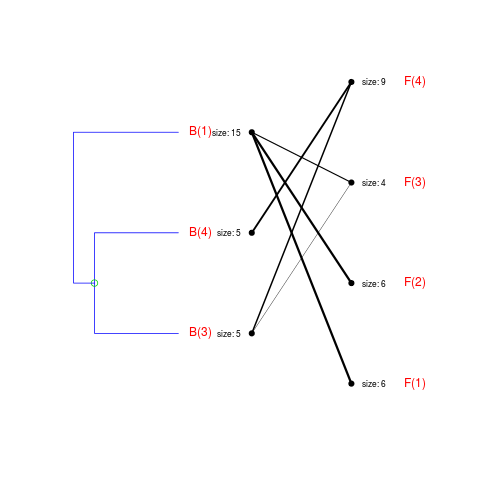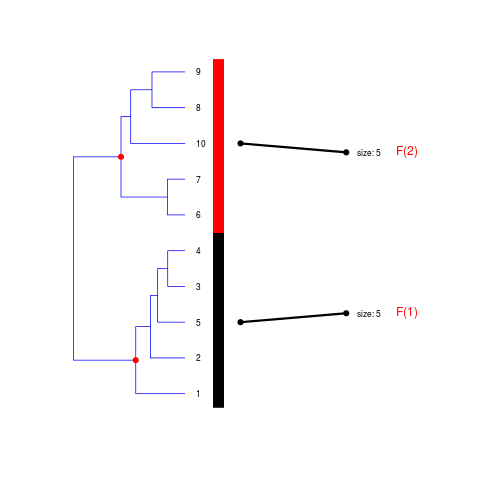Supported by Dr. Osamu Ogasawara and  providing providing  . . |
|
Last data update: 2014.03.03 |
Plot the bi-graph determined by the branches in the tree and the flat clustersDescription
Usage
drawTreeGraph(weight, current.order, coordinates, tree, dot = TRUE,
line.wd = 3, main = NULL, expanded = FALSE, hclust.obj = NULL,
labels = NULL, cex.labels = 1)
Arguments
Details The Valuea list of components including:
Author(s)Aurora Torrente aurora@ebi.ac.uk and Alvis Brazma brazma@ebi.ac.uk ReferencesTorrente, A. et al. (2005). A new algorithm for comparing and visualizing relationships between hierarchical and flat gene expression data clusterings. Bioinformatics, 21 (21), 3993-3999. See AlsoflatVShier Examples
### simulated data
parent.clustering <- c(rep(1, 15), rep(2, 10))
# replace the branch '2' by its children '3' and '4'
children.clustering <- c(rep(1, 15), rep(3, 5), rep(4, 5))
flat.clustering <- c(rep(1, 6), rep(2, 6), rep(3, 4), rep(4, 9))
split <- rbind(c(0, 1, 2), c(2, 3, 4))
weight <- table(children.clustering, flat.clustering)
current.order <- list(c(3, 4, 1), 1:4)
coordinates <- list(c(-1, 0, 1), c(-1.5, -0.5, 0.5, 1.5))
tree<-list(heights = c(1, 0.8), branches = split)
drawTreeGraph(weight, current.order, coordinates, tree)
### expanded tree
set.seed(0)
myData <- matrix(rnorm(50), 10, 5)
myData[1:5,] <- myData[1:5, ] + 2 # two groups
flat.clustering <- kmeans(myData, 2)$cluster
hierar.clustering <- hclust(dist(myData))
weight <- matrix(c(5, 0, 0, 5), 2, 2)
colnames(weight) <- 1:2; rownames(weight) <- c(6,8)
current.order <- list(c(6, 8), 1:2)
coordinates <- list(c(0.25, 0.75), c(0.25, 0.75))
tree <- list(heights = hierar.clustering$height[9],
branches = matrix(c(9, 6, 8), 1, 3))
drawTreeGraph(weight, current.order, coordinates, tree,
expanded = TRUE, hclust.obj = hierar.clustering,
dot = FALSE)
Results
R version 3.3.1 (2016-06-21) -- "Bug in Your Hair"
Copyright (C) 2016 The R Foundation for Statistical Computing
Platform: x86_64-pc-linux-gnu (64-bit)
R is free software and comes with ABSOLUTELY NO WARRANTY.
You are welcome to redistribute it under certain conditions.
Type 'license()' or 'licence()' for distribution details.
R is a collaborative project with many contributors.
Type 'contributors()' for more information and
'citation()' on how to cite R or R packages in publications.
Type 'demo()' for some demos, 'help()' for on-line help, or
'help.start()' for an HTML browser interface to help.
Type 'q()' to quit R.
> library(clustComp)
> png(filename="/home/ddbj/snapshot/RGM3/R_BC/result/clustComp/drawTreeGraph.Rd_%03d_medium.png", width=480, height=480)
> ### Name: drawTreeGraph
> ### Title: Plot the bi-graph determined by the branches in the tree and the
> ### flat clusters
> ### Aliases: drawTreeGraph
> ### Keywords: clustering comparison
>
> ### ** Examples
>
> ### simulated data
> parent.clustering <- c(rep(1, 15), rep(2, 10))
> # replace the branch '2' by its children '3' and '4'
> children.clustering <- c(rep(1, 15), rep(3, 5), rep(4, 5))
> flat.clustering <- c(rep(1, 6), rep(2, 6), rep(3, 4), rep(4, 9))
> split <- rbind(c(0, 1, 2), c(2, 3, 4))
> weight <- table(children.clustering, flat.clustering)
> current.order <- list(c(3, 4, 1), 1:4)
> coordinates <- list(c(-1, 0, 1), c(-1.5, -0.5, 0.5, 1.5))
> tree<-list(heights = c(1, 0.8), branches = split)
> drawTreeGraph(weight, current.order, coordinates, tree)
$b.coord
[1] -1 0 1
$f.coord
1 2 3 4
-1.5 -0.5 0.5 1.5
$x.coords
[1] 0.70 1.65
>
> ### expanded tree
> set.seed(0)
> myData <- matrix(rnorm(50), 10, 5)
> myData[1:5,] <- myData[1:5, ] + 2 # two groups
> flat.clustering <- kmeans(myData, 2)$cluster
> hierar.clustering <- hclust(dist(myData))
> weight <- matrix(c(5, 0, 0, 5), 2, 2)
> colnames(weight) <- 1:2; rownames(weight) <- c(6,8)
> current.order <- list(c(6, 8), 1:2)
> coordinates <- list(c(0.25, 0.75), c(0.25, 0.75))
> tree <- list(heights = hierar.clustering$height[9],
+ branches = matrix(c(9, 6, 8), 1, 3))
> drawTreeGraph(weight, current.order, coordinates, tree,
+ expanded = TRUE, hclust.obj = hierar.clustering,
+ dot = FALSE)
$b.coord
[1] 0.2222222 0.7777778
$f.coord
[1] 0.25 0.75
$x.coords
[1] 0.50 1.45
>
>
>
>
>
> dev.off()
null device
1
>
|

